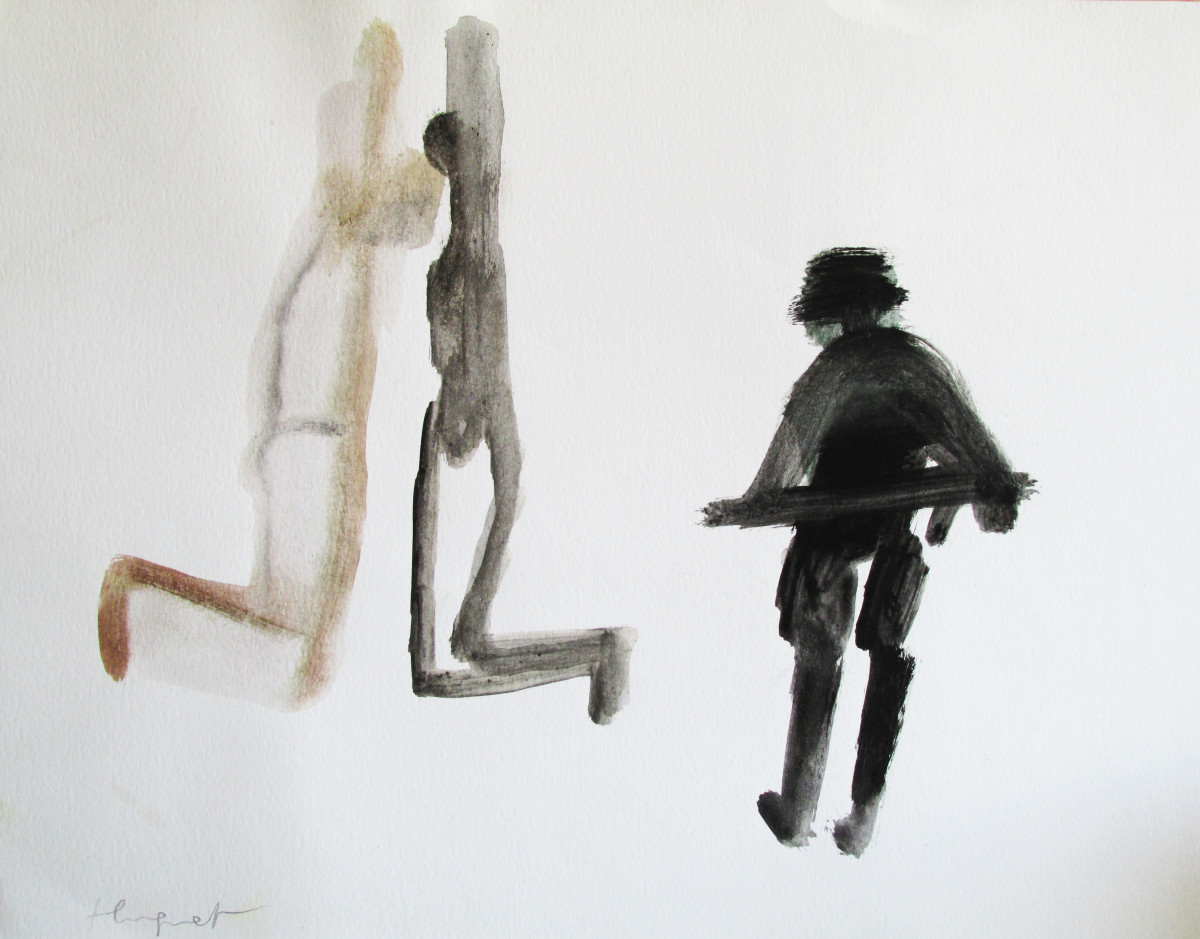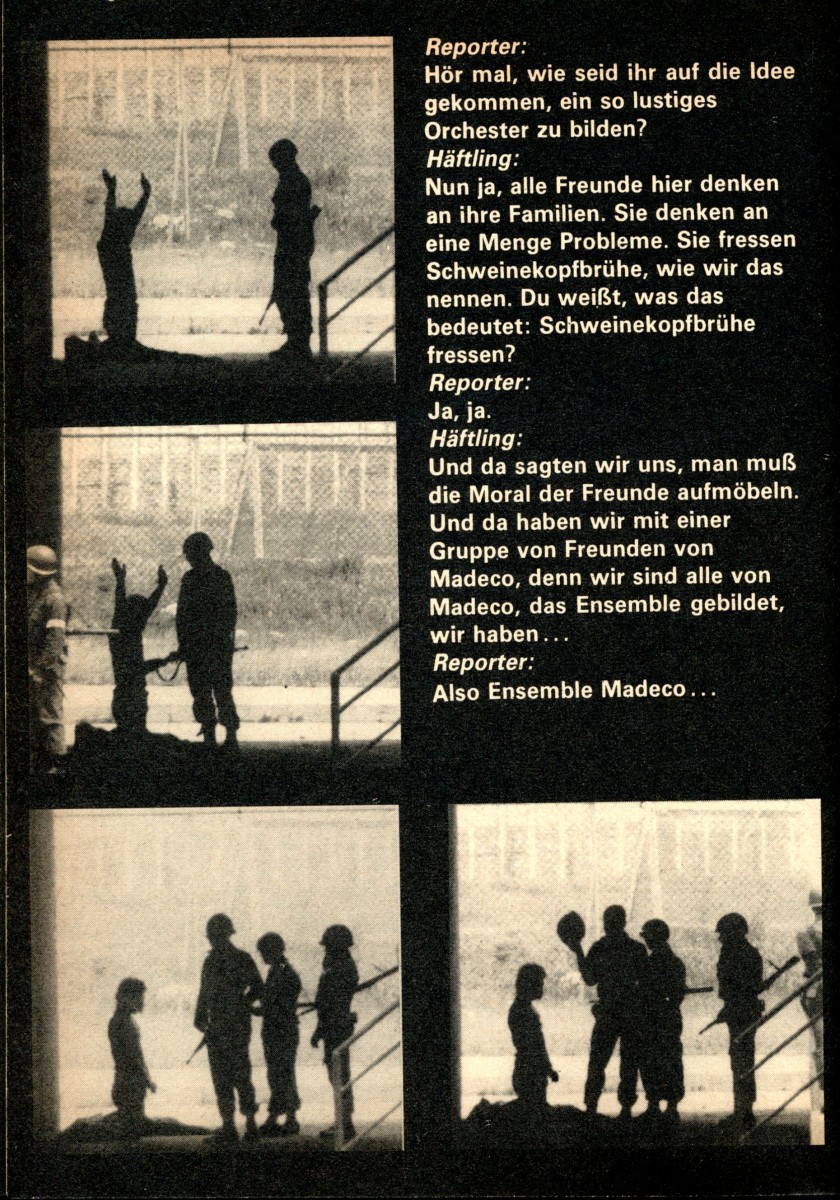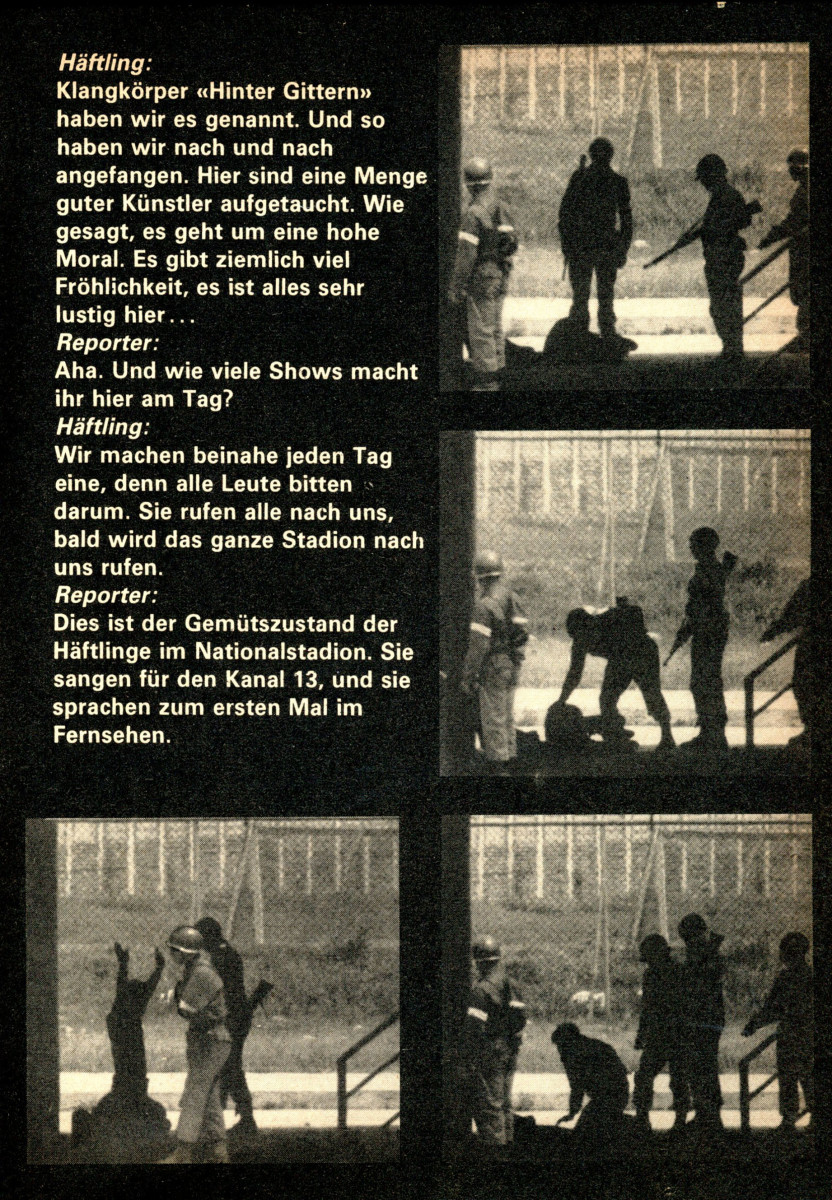
Katherine Hite: On January 26, 2016, a five-man indie band called Jimmy Button played at a music festival in Santiago, Chile. The band members are guides who work at the Museum of Memory and Human Rights—a unique Chilean educational institution focusing on the abuses of the Pinochet dictatorship (1973-1990) that is now visited by more than 10,000 people a month. “We want a guided visit from Jimmy Button!,” one fan from the Museum yelled from the audience. The band has proved cathartic for the guides, whose day jobs are intense.
Indeed, many visitors to the Museum enhance their experience through guided tours with the professional docents who take them through the displays of state-sponsored terror and violence, that include depictions of the torture, imprisonment, disappearance, and execution of thousands.
To be sure, it is not an easy place to visit—or to work. In a series of conversations over several months, Jordi Huguet, a guide in Chile’s Museum of Memory and Human Rights (and the drummer in the Jimmy Button band) shared his thoughts on the emotional and professional struggles he and his colleagues face on a daily basis as they try and guide visitors from around the world through Chile’s dark and painful past.
Jordi Huguet: For some time now I have been in crisis. It is a crisis of faith about how well I am doing my job, about whether we’re really pulling off what we hope to achieve with the Museum. Ironically, it’s a crisis tied to the surprising popularity of the Museum today.
Chile’s Museum of Memory has become a model in Latin America, a real go-to tourist site. It is actually ranked number one on Trip Advisor! And now the Museum is a required high school field trip for lots of schools.
But now that memory has become “pop”—popularized, accessible, easy, at least on the surface—I’m finding it harder and harder to approach visitors with the kind of logic and pace that’s expected of a Museum dedicated to memories of repression. Instead of constantly having to deliver rote, authoritative monologues to hundreds of visitors who may or may not be interested, I want to be freed up for different kinds of exchanges with our visitors. I want to imagine our being open to conflicting views of the past, within the walls of an institution I deeply care about.
Ideally, I would be a facilitator encouraging people to share their memories, putting distinct perspectives into play from all over the place. But this would require a radically different approach to guided visits, one that pays close attention to how people really think and feel. And I confess that how I feel is kind of contradictory, because to pull off this approach would also be emotionally draining.
We were urged to be careful with our terminology, to be precise. We knew we were confronting something controversial, something complex, but I don’t think we had any idea what this really meant.
Rites of Passage
Katherine Hite: When the Museum was inaugurated in 2010, no one could predict what kind of audience it would attract, beyond local and international human rights-affiliated communities and individuals, as well as leftist foreigners and small sectors of dedicated Chileans who embraced the project of Salvador Allende (1970-1973) and confronted the pariah of Pinochet (1973-1990). By the time the Museum opened, Allende’s own party leaders had re-ascended to the presidency, the ex-dictator was dead, and dozens of human rights violators had been prosecuted. Yet silence about Chile’s painful past predominates, in good part because Chileans do not like to revisit the confrontations of the past, nor the divisive debates over causes and consequences that confronting memory brings. While there is a social consensus that Pinochet was a dictator who committed gross violations of human rights, memories and perspectives among Chileans continue to be divided—about why the coup d’etat occurred, why the brutality, why the regime lasted so long, and at what cost, or even for what benefit.
The structure and content of the Museum reflect this problem. The narrative of its exhibits begins with the day of the military coup d’etat in 1973 and ends with the celebration of an elected civilian president in 1990. Meant to provide a degree of moral reparations for the human rights victims of the dictatorship, the Museum does not provide any context for the coup. Its curators believe that nothing can justify the brutal overthrow of a democratically elected government, nor the regime’s intense, interminable repression. Moreover, in seeking to offer a reconciliatory message, the Museum’s narrative implies that with the 1990 return to democracy, all is well in Chile. As one might imagine, the 1973-1990 narrative timeline and the Museum’s own silences about the past and present can present predictable pitfalls for a guide.
Jordi Huguet: I began as a guide the first year the Museum opened. I was totally fired up, full of desire to be a part of this new collective project for Chile. It was really overwhelming. It was heavy. We were immersed in the Museum’s purpose and script, in how to present the exhibits. Many of us were swamped with the tremendous amount of information we needed to absorb and master, coupled with processing how emotionally charged the information was. We were urged to be careful with our terminology, to be precise. We knew we were confronting something controversial, something complex, but I don’t think we had any idea what this really meant.
In that early period, I remember the knot in my stomach each time I faced a new group of visitors, particularly those we guided on the weekends. The weekend groups tended to be a random assortment of people who had all kinds of political perspectives and memories. During those first couple years of the Museum, visitors tended to be the dictatorship’s direct victims, who often lived with a pent-up emotional burden and were able, in part, to release it, at least temporarily, within the Museum. It often exposed us to an emotional letting-loose in ways we weren’t prepared for. Over time, each of us as guides found ways to approach these sometimes pretty dramatic situations. It was a kind of trial by fire.
Then I began to calm down. I began to feel empowered; I felt I had processed and understood the Museum, and I strongly identified with the Museum. I started to come to terms with my own memories. I really began to identify with the victims.
I am not Chilean. I am a Spaniard, from Barcelona, and my status as a foreigner—as a Spaniard and a Catalan—clearly influences how I relate to memory in Chile and to my experience with the Museum and its many visitors.
So as a Spaniard and Catalan, I strongly identified with the memory of those who lost the Spanish Civil War in 1939, with the pain of what was not to be. I come from a family that suffered a lot of abuse, social injustice—my grandfather was from a very poor peasant family, he worked in the mines, he fought on the Republican side and was imprisoned for five years, he got the death penalty, he was a prison laborer. There was abuse, abandonment, and loss in my family through and through. This feeling of victimhood allowed me to develop a voice as a guide that worked, at least for a while. I became very productive for the Museum because I began to have a sense about how to narrate what I really wanted to say. I was passionate. Frankly, no matter how much some might claim otherwise, this doesn’t just happen on its own.
I become a mediator in these “battles over memory,” in which those who lived through the dictatorship feel recognized as valid interlocutors, as carriers of memory.
A Darker Side
Jordi Huguet: But then I went through a darker time, when I realized that I was leading visits that generated serious tension within the groups. I was also in therapy, and as I worked through my own past and my sense of victimhood, I also began to understand something else—it was something about my relation to the role of the victimizer. I started to connect and need to come to terms with this emotion, in the Museum, as a Spaniard, that image of the conquistador, the colonial legacy my image even subconsciously evoked for Chileans, and then even for myself, as a brusque father of two little boys.
I remember it hit me when I was walking through the Museum’s temporary Fernando Botero exhibit, his Abu Ghraib torture series that depicts the US victimizers as well as the Iraqi victims. I realized then and there that I had to look for the victimizer within myself—and to confront it. I began to see how the idea of nunca más, “never again,” wasn’t working for me. There was no longer some neat division between victims and victimizers. It was important to recognize the potential of my being a victimizer.
And then in an ironic way, in a kind of dark humorous way, I also started to feel like each guided visit essentially reproduced the story of the dictatorship as a model of success, which goes something like this:
If you want to orchestrate a successful dictatorship, first massively repress for a short, intense period of time, eliminating any potential opposition, then issue a whole series of decree laws and states of emergency, institute curfews and the like, and be sure to invent news stories that cover up grim human rights violations and instead describe them as shoot-outs by the bad guys, the subversives. Also hammer the contrasts between the pre-coup chaos and post-coup political stability, economic prowess, societal devotion to church and family.
So I felt a new kind of crisis, one not necessarily productive for the Museum as an institution, but one that I’m convinced is productive for the visitors and for me, even though it is also exhausting. I began to try to practice self-care, self-awareness. I have now distanced myself from the narrative of the Museum, and I have begun incorporating the stories of others—stories emanating from a range of visitors, stories that are not in the Museum.
There are different ways to approach how to talk about torture and torture victims with Museum visitors. When I try to explain to student visitors, “What is torture?” I ask, “What is the most sacred thing you have, the most sacred? Because this is what the dictatorship wanted to snatch away from you.” If I don’t do it like this and I get into a detailed description of torture, I end up feeling too morbid.
One can understand that as a victim, though, you might want people to understand what you lived through. It depends a lot on how victims have dealt with their experiences, and sometimes they want me to present a more detailed, violent account. Once during a guided visit, a man who had been tortured was in the group, and we were standing next to the Museum’s display of “the grill” (the metal bed frame, cables, and control box used to torture prisoners by electric shock), and he took the cables, and explained, really like a professional, how they tortured him. I had to walk away from the group for a little while.
So often we’re only conscious of the dark side, and we see everything as black and white. When I was younger I thought I was very “wise” as I looked at the world through a dark analytical lens, and now I realize I’m wiser appreciating the nuances that are also hard to see.
In short, I opened up to a place of memory that is real. I enter into a story of a story, which is what a lot of memory is about. I invite the visitors to enter the story, to participate, and to say what they think. I become a mediator in these “battles over memory,” in which those who lived through the dictatorship feel recognized as valid interlocutors, as carriers of memory. I have had to dig really deep, to think not about “the other,” but about myself through the other. All this requires a great deal of energy. And it can be a controversial way to guide, one that visitors may or may not like.
And here is where it could get more interesting for the Museum, because the institution no longer controls the narrative—if it ever really did.


The Visitor Boom
Katherine Hite: As it enters its sixth year, the Museum is having serious trouble complying with all the guiding requests. Most visitors do not take a personally guided visit, but hundreds do. The majority of guided visit requests come from public high schools, but other groups also take guided tours—among them human rights associations, ex-political prisoner groups, organizations of families of the dead and disappeared, international traveler groups from all over the world, Rotary clubs, Boy Scout groups, public agencies, and many others. Even units from the military and police request guided visits, which are always tricky and often unpleasant.
For me, guiding visits has become like tuning a radio dial, like arranging a musical score.
Jordi Huguet: Visitor enthusiasm about coming to the Museum varies a lot. For school kids, clearly, the visit for them isn’t a choice. Nor is it necessarily a choice among the soldiers and police officers. Nevertheless, I am convinced that everyone who comes into the Museum asks themselves at one point or another, consciously or not, out loud or not: “Where am I represented here, inside this Museum? What does this Museum have to do with me?”
Indeed, I have often asked myself that very question.
A young Basque visitor was on the tour once. He was about eighteen, very sure of himself, a little cocky, taking the visit in stride. Then we arrived to the exhibit about the 1980s, part of which shows a video of a policeman shooting a young woman in the head. He sees that, and he begins to cry. He breaks. Something happened, that got into him, and he fell apart.
Lots of foreigners who visit are just looking for the “selfie” photo shot, but I do also see foreigners connecting their histories in different ways to what they’re seeing in the Museum. Brazilians identify with a lack of symbolic markers in Brazil. Argentines are very proud of their processes of coming to terms: their trials, their repudiation of the military. Mexicans often evoke the memory of the repression of 1968. And from the United States, I think what predominates is a sense of guilt.
For me, guiding visits has become like tuning a radio dial, like arranging a musical score. At the beginning of a guided visit, I try to approximate an idea of those around me through their gazes, stances, gestures, the words they use, the ways they enter the conversation, or don’t. How I pitch the narrative either hits or misses my initial instinctual impression, I’m trying to synchronize what I am feeling or aware of, with the feelings and attitudes the visitors and I share, and the postures we take on. Like when visitors cross their arms when they speak, it’s a sign of a certain reserve, and that then triggers a similar pose by me, but I need to resist it, I need to transcend it a bit. Those first moments of a visit are so important because what’s in play is the future of a good or bad conversation between the mediator-guide and the visitor. And if we grant that this kind of non-verbal communication is important, then we see that all kinds of cultural and identity-based dimensions are also at play. It is as if we are constantly editing our stories or configuring ourselves as we relate to the world around us.
Prejudice is also at play. Since I am a foreign guide, Chileans immediately notice my accent—a signal that we don’t form a common “clan” or “family,” that I do not belong to the “family of Chileans.” This can become an initial way to invalidate what I may have to say. Invalidation of the various Museum guides, Chileans included, happens all the time, based on the guides’ physical features—age, color, hair or eye color, or accent. In my case, the fact that I’m a Spaniard (though if I present myself as a Catalan as it has other connotations for Chileans) leads to all kinds of assumptions. Being from Spain, my accent, my blue eyes have tended to arouse suspicion, to cast me as an imposter, or maybe even the figure of a victimizer.
Over time, I have learned to work with the suspicions of visitors who question how I could possibly explain Chile’s history to a Chilean. In my best moments, I push myself not to be defensive, and this opens up understandings of the Museum beyond just the stereotypical Chilean memory divisions.
I have come to think of the Museum not just as where I go to work, but like a family relative’s home, like my grandmother’s house. Like a home, it invites, welcomes, it provides a sanctuary for our shared, most intimate memories and secrets, but also for all the tensions, tears, and dysfunctions of any family home. Sometimes I walk alone in the Museum, just to observe how visitors are interacting with the exhibits, to see what they focus in on, to speculate about why and what they may be thinking, here in our house.
